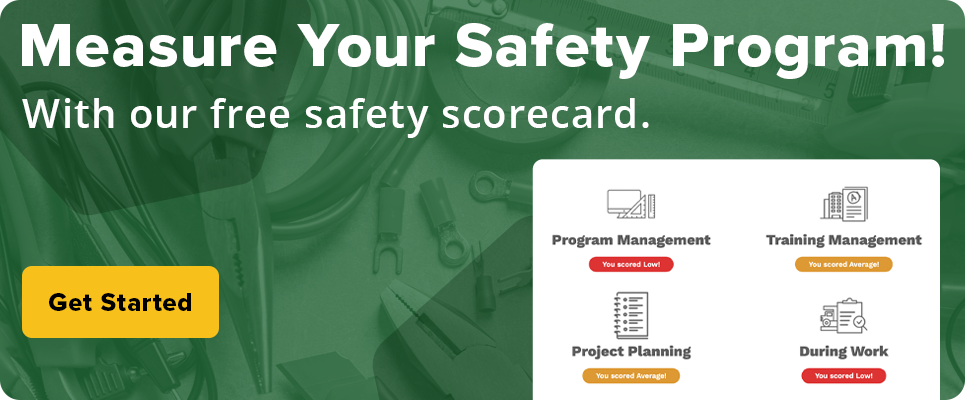
If you’re a construction company owner or manager, you understand just how critical it is to create a formal health & safety program for your company. Perhaps you are already doing some of the basics, such as providing safety training, developing site-specific safety plans, or conducting periodic safety meetings.
The firms that excel in safety all have one thing in common: A strong commitment from ownership and management toward the safety & well being of every worker. These companies have happy, productive workers, and they have lower than average worker’s compensation premiums, which gives them a competitive advantage in their industry.
Now, many companies say they have this commitment. You can visit the website of any contractor and usually see mention of it. But they often lack the will to actually see it through.
Jobs that are behind schedule suddenly stop having safety briefings or inspections. Some workers pick up on the urgency of their management and start cutting corners when it comes to safety –all for the sake of profitability or fear of losing their jobs. That is not a safety culture.
Whether you’re the leader of a single crew or an entire company, the first time you prioritize production or results over safety, you will have sent the message loud and clear to your workers that your commitment to safety is just an empty statement on your website.
(If you liked this podcast about safety, check out more great content from the Mobile Workforce Podcast by WorkMax)
How will you motivate your workers to go above and beyond on the next project if they don’t truly believe you have their best interests at heart?
Top 5 Ways To Foster Your Safety Culture:
1. Sign A Commitment to Safety Letter
Write a personal letter that outlines your own commitment to safety and ensure every worker receives a copy when they are hired. Have each worker acknowledge the letter and add their own written commitment to safety as part of the hiring process. They could do this via a simple checklist. Doing this is a great way to hold both management & employees accountable.
2. Establish a Joint Health & Safety Committee
Establish a joint health & safety committee of workers from across the organization. The goal of this committee will be to inform safety policies and identify ways to improve safety over time. Empower committee members by treating them as equals and not just employees. Actually, implement their ideas so that the rest of your organization and the committee members themselves view the committee as the safety authority for your company. The best safety programs are ones where workers feel ownership.
3. Set A Budget
Create a dedicated budget for safety within your organization that can be used for training, equipment, productivity tools, etc. Make sure the amount is appropriate for your company size, and review the budget annually. According to the National Safety Council, every $1 spent on safety returns between $2-$6. That’s a great investment
4. Talk Safety First. Results Second.
Review safety measures being taken on job sites prior to EVERY production-related discussion. Showing your own personal commitment to your worker’s health & safety in some way every day is a quick & easy way to remind them that you care. Make it clear that your example should be followed by the entire management team. It will quickly become a habit and often leads to illuminating discussions that can benefit the company in other areas than just safety.
5. Get Advice From The Best
Seek out advice within your industry via professional associations or think-tank groups and bring those findings to your safety committee. National and regional trade groups like the National Roofing Contractors Association, Midwest Roofing Contractors Association, Association of General Contractors, and Mechanical Contractors Association of America are all great examples. They each have developed safety resources and working groups to promote safety best practices amongst their membership.

Bonus Tip: Celebrate Safety Success.
Provide updates to your organization and workers on your safety record on a regular basis, and take the time to point out particular efforts of individual workers. You could do this by posting on a board in your office or sending a dedicated email. You could even use weekly safety meetings to acknowledge the efforts of an individual worker or a group.
Safety incentive programs that reward employees for certain behaviors can be a good idea as long as they don’t discourage or punish workers for reporting unsafe conditions. For example, incentivizing workers who complete their safety planning activities thoroughly is better than incentivizing workers for a lack of recordable injuries on a project. The latter could result in workers hiding injuries or unsafe conditions, and that could land your company in trouble with OSHA.
Celebrating the right behaviors and commitment to safe work is another great way to prove to your workers that your commitment to a culture of safety isn’t just an empty promise. It’s something that you live every day.
Next Actions
Hopefully, by now, you have a better idea of how to foster your company’s safety culture.
SafetyHQ is a construction safety app used by thousands of contractors every day to remove the administrative burden from their health & safety program, allowing them to measure success and, ultimately, save money.

SafetyHQ could make it easier for your company to strengthen its safety culture. Here are some fantastic & free resources available on our blog that you can use to create a strong construction health & safety program.
Share Article
Keep on current news in the construction industry. Subscribe to free eNews!



